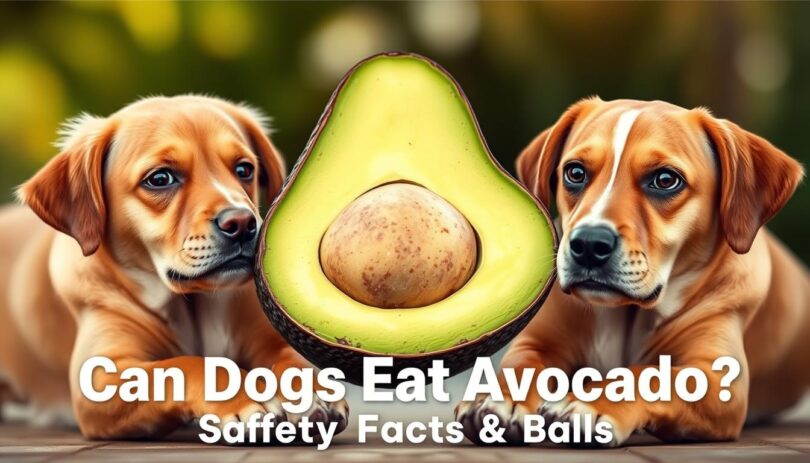Did you know 1 in 3 pet owners share human food with their furry companions without checking safety guidelines? This surprising habit raises questions about which foods are truly safe—including the popular green fruit many love. While avocados pack nutrients, their suitability for pets requires careful evaluation.
This article explores the pros and cons of feeding avocado to your canine friend. The flesh offers vitamins like A and E, along with fiber that supports digestion. However, risks like persin—a natural toxin—and choking hazards from pits demand attention. Even small amounts might trigger stomach upset in sensitive animals.
Responsible pet care means balancing potential benefits with safety. Always remove the pit and skin before offering a bite-sized portion. If your dog shows signs of discomfort, consulting a vet ensures quick action. Stay tuned for practical tips on introducing new treats while prioritizing your pup’s well-being.
Understanding Avocado’s Nutritional Benefits and Risks
While nutrient-rich for humans, not all parts of this popular fruit are safe for canine consumption. Let’s break down what makes the edible portion beneficial and why other components require vigilance.
Exploring the Nutritional Value for Dogs
The soft green flesh contains healthy fats and vitamins like A and E. These nutrients support skin health and immune function. Fiber in the fruit aids digestion, but moderation is key—too much may cause stomach upset.
Identifying Persin and Choking Hazards
Persin, a natural toxin, appears in higher concentrations in leaves, skin, and pits. Mild exposure might lead to vomiting or diarrhea. The pit also poses physical risks—its size and hardness can block airways or damage teeth.
Small portions of ripe flesh are generally safer. Always monitor pets after introducing new foods. If symptoms like lethargy or loss of appetite occur, contact your vet immediately.
Preparing Avocado Safely for Dogs
Proper preparation transforms this fruit from a risky snack to a safe treat. Focus on eliminating hazards while preserving nutritional value. Follow these steps to ensure your pet enjoys the benefits without unnecessary risks.
Proper Preparation Methods
Start by washing the avocado thoroughly. Cut it lengthwise and twist to separate the halves. Remove the pit immediately using a spoon—never let pets near this choking hazard. Scoop out the flesh carefully, avoiding contact with the skin. Mash or slice the soft inner portion into bite-sized pieces.
Store unused portions in an airtight container for up to two days. Discard any browned areas, as oxidation reduces freshness. Never serve avocado mixed with spices, onions, or other additives.
Recommended Serving Sizes and Frequency
Limit portions to one teaspoon per 10 pounds of body weight. For a 30-pound dog, that’s about one tablespoon weekly. High fat content means overfeeding could lead to pancreatitis. Treats shouldn’t exceed 10% of daily calories.
Introduce avocado gradually. Watch for signs like loose stools or vomiting. If reactions occur, discontinue use and consult your vet. Remember—this fruit is a supplement, not a meal replacement.
Health Implications When Dogs Eat Avocado
While small amounts of avocado flesh might seem harmless, certain components can trigger serious health issues in pets. Understanding these risks helps owners make informed decisions and act quickly if problems arise.
Digestive Upset and Pancreatitis Considerations
Mild symptoms like vomiting or diarrhea often appear within hours of ingestion. These reactions stem from persin, a natural compound in avocado skin and pits. Sensitive animals may also show reduced appetite or lethargy.
The fruit’s high fat content raises another concern. Overconsumption can inflame the pancreas, leading to pancreatitis—a painful condition requiring urgent care. Smaller breeds face higher risks due to their size.
Pits pose dual threats: choking hazards and intestinal blockages. Swallowed fragments may damage the digestive system, sometimes needing surgical removal. Always keep these parts away from curious pets.
If your companion shows unusual behavior after eating avocado, contact a veterinarian immediately. Early intervention prevents minor issues from escalating. For tailored advice, review expert guidance on safe feeding practices.
Avocado and dogs: What You Need to Know
Even vigilant pet owners might miss subtle signs of distress after their companion samples this fruit. Recognizing early symptoms can mean the difference between quick recovery and lasting health issues.
Recognizing Adverse Reactions and Toxicity Signs
Watch for vomiting, diarrhea, or excessive drooling—common indicators of gastrointestinal upset. Lethargy and refusal to eat often follow within 12 hours. Severe cases may involve difficulty breathing if pits cause blockages.
Persin, the natural compound in avocado skins and leaves, affects some pets more than others. Smaller breeds or those with sensitivities might react to trace amounts. The pit’s size creates choking hazards, while sharp edges risk intestinal tears.
Immediately remove any remaining avocado if your dog eats unsafe parts. Contact your vet if symptoms persist beyond six hours. Avoid homemade guacamole—garlic and onions added to recipes heighten toxicity risks.
Check commercial treat labels for hidden avocado derivatives. Monitor your pet closely for 24 hours after accidental ingestion. Early intervention prevents minor issues from becoming emergencies.
When in doubt, snap a photo of what your dog consumed. Share it with your veterinarian for tailored advice. Quick action paired with informed observation keeps tails wagging safely.
Expert How-To Tips for Integrating Avocado into Your Dog’s Diet
Veterinarians often emphasize that even safe human foods require tailored strategies for pets. Balancing curiosity with caution ensures your companion enjoys variety without compromising health. Let’s explore expert-backed methods to introduce this nutrient-rich fruit responsibly.
Consulting Your Veterinarian for Personalized Advice
Dr. Sandra C. Mitchell, DVM, advises pet owners to schedule a checkup before adding new foods. Health factors like weight, allergies, and existing conditions influence safe portion sizes. For example, dogs prone to pancreatitis may need stricter limits on fatty treats.
Discuss how avocado flesh fits into your pet’s overall calorie intake. Vets typically recommend treats under 10% of daily meals. They might also suggest commercial products with controlled avocado content, like Wellness CORE Digestive Health formulas.
Safe Substitutes and Complete Nutritional Alternatives
If risks outweigh benefits, try safer options. Blueberries offer antioxidants, while steamed carrots support dental health. For pets needing healthy fats, omega-3 supplements often provide similar benefits without persin concerns.
Monitor reactions closely during initial trials. Loose stools or itching signal sensitivity. Always keep emergency vet contacts handy. Remember—moderation and professional guidance turn potential hazards into occasional delights.
Final Considerations for Safe Avocado Consumption in Dogs
Balancing nutritional benefits with potential risks requires thoughtful choices. The flesh offers vitamins and healthy fats when served properly. Always discard pits and skins—these parts contain persin and pose choking hazards.
Monitor your pet closely after introducing this fruit. Watch for vomiting, diarrhea, or lethargy. Contact your vet immediately if symptoms appear. Moderation remains critical—even safe foods can cause issues if overfed.
Consult your veterinarian before making dietary changes. They’ll assess your companion’s health history and recommend appropriate portions. Pair their advice with proper preparation methods for optimal safety.
Informed decisions prioritize your dog’s well-being. By understanding risks, practicing moderation, and seeking professional guidance, you support long-term vitality. Let knowledge guide every treat you share.
FAQ
Can dogs safely eat avocado flesh?
Small amounts of ripe avocado flesh are generally safe for most dogs, but avoid the skin, pit, and leaves. The fruit contains persin, a toxin that’s concentrated in inedible parts and may cause issues in sensitive pets.
What parts of avocados are dangerous for pets?
The pit, skin, and leaves pose the highest risk due to persin concentration and choking hazards. The pit can also obstruct the digestive tract, requiring emergency care.
How do I recognize persin toxicity symptoms?
Watch for vomiting, diarrhea, or lethargy. Severe cases may involve difficulty breathing. Contact your vet immediately if these signs appear after ingestion.










Leave a Comment